English, American & Far Eastern Bike Frames
Post-1970 21.5in–22.5in
All our categories can be found in the sub-menu below – clicking on the category you want look at will get you directly to that page.
PLEASE NOTE: I measure all British, American and Japanese frames in inches ctt (centre to top) and convert to the nearest cm, conversely I measure all European and Italian frames in centimetres ctc (centre to centre) and convert to the nearest 0.25in.
A problem with all frames measured ctt is that the top measuring point varies from maker to maker and I try and second guess where the maker intended his measurement to be to – some mean top of top top tube, others the very top of the seat lug, and others to the seat lug top line…
FRAME SIZING
Do not assume that you will need a frame sized the same as your modern one – either seat tube or top tube. Fashion plays a great part in frame design and sizing. In the early years of the 20th century frames were sized as large as possible with virtually no seatpost showing … by contrast riders were advised in the 1920s to have as small a frame as possible.
Race/road frames from the 1920s/early 1930s will generally be sized about 3–5cm smaller than a modern frame but with a much longer top tube and shorter stems. Towards the end of the 1930s larger frame sizes became fashionable – up to 2cm larger than a modern frame. Top tube lengths were still longer used with shorter stems. In the 1940s and 50s frames were sized a bit larger still – 3–4cm more than a modern frame still with longer top tubes and shorter stems. In the 1960s and 1970s frames gradually reduced in size until the late 1980s. At the same time top tubes began to get shorter and stems longer.
Standover height is NOT a useful method of frame sizing either with modern or old frames. Short legged riders will rarely have much or any clearance between the top tube and their crotch unless the frame has a sloping top tube design. Taller riders also face other problems. A complete guide to frame sizing for frames of different periods is impossible to detail here. For frames from the 1980s onwards I suggest buyers look at Dave Moulton’s contributions on frame sizing. Possibly start off with http://davesbikeblog.squarespace.com/blog/2006/2/27/a-different-thought-on-frame-sizing.html
and then look at: http://www.davemoultonregistry.com/MoultonFrameSizeChart
I am willing to advise any customer on frame sizing with older frames.
Featured Frames
British and American road frames smaller than 21.5in
British and American road frames 21.5in–22.5in (look below)
British and American road frames larger than 22.5in
Bargain Basement
Classic Road frames pre-1970 smaller than 21.5in
Classic Road frames pre-1970 21.5in–22.5in
Classic Road frames pre-1970 larger than 22.5in
Classic Track & Road-Track frames pre-1970
European frames 56cm or smaller
European frames larger than 56cm
Italian frames 56cm or smaller
Italian frames larger than 56cm
Lo-Pro & Retro Time Trial frames
Touring frames
Track frames

Please contact me at: hilarystone@hilarystone.com to check on availability and confirm shipping cost.
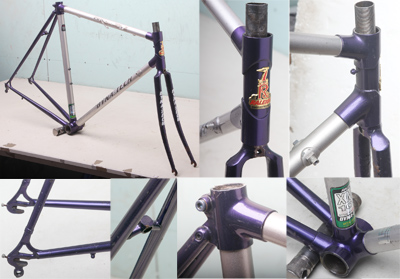
DYNA-TECH CRONOS MMC 1992 21.5in
Seat Tube (ctt): 21.5in (55cm)
Top Tube (ctc): 21.5in (55cm)
Rear dropout width: 130mm
Wheel size: Sprints/700C with a brake drop of 48mm
Frame tubing: Raleigh/BP Aluminium MMC tubes
Seatpost size: 27.2mm
In 1987 Raleigh SBDU moved to Nottingham to join the former Carlton Lightweight bike unit which had moved to Nottingham six years earlier. The two units were merged over the next year or so to form Raleigh Special Products Division. They developed the Dyna-Tech bonded frames which formed the mainstay of SPD road frames for four or five years. Most used steel tubing bonded into aluminium lugs. Some later ones used titanium and a very few aluminium metal matrix supplied by BP metals division. Unlike straightforward aluminium alloys which are similarily stiff, metal matrix composites are much stiffer. With MMC aluminium tubing Raleigh were able to use main tubes of identical diameter to steel frames which in a normal aluminium alloy would have resulted in a excessively flexible frame. The net result was a an adequately stiff frame which was very light – if I remember correctly was under 1.2kg. Carbon-fibre frames at this time were quite a bit heavier…
The MMC frames were built in tiny quantities in 1992–3 and this one was tested in Cycling Plus 14 March 1993 issue. The top tube decal is in very poor condition and the paint on the steel forks needs redoing – its bubbling. I’ve never seen another… £325

RON COOPER ROAD FRAME c2000 22in
Seat Tube (ctt): 22in (56cm)
Top Tube (ctc): 21.75in (55.5cm)
Rear dropout width: 130mm
Wheel size: Sprints/700C with a brake drop of 48mm
Frame tubing: Columbus mix
Seatpost size: 27.2mm
Ron Cooper learnt the trade of framebuilding at Gillotts in the 1940s – Gillott frames are of a very consistent high quality and that carries over into Ron’s frames. Ron Cooper continued to build Gillott frames until about 1970. He continued until close to his death in 2012. This frame dates I think from the late 1990s – he rarely numbered his frames. This frame has an ovalised top tube and oversize down tube combined with a carbon-fibre fork with 1in threadless headset. Possibly Ron used a mixture of Columbus tubing – it looks like a Minimax top top tube and EL oversize down tube. The fillet brazing and lugs are beautifully executed. The paint is excellent with a few small marks. £345
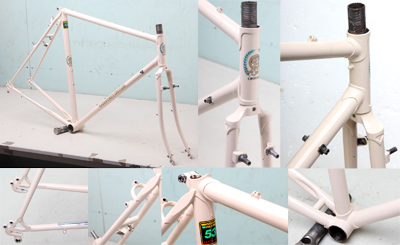
GEOFFREY BUTLER TOURING FRAME 1990s 22in Cliff Shrubb built
Seat Tube (ctt): 22in (56cm)
Top Tube (ctc): 22.5in (57cm)
Rear dropout width: 130mm
Wheel size: 700C
Frame tubing: Reynolds 531 Super Tourist
Seatpost size: 27.2mm
Geoffrey Butler frames were built by a number of framebuilders over the years. This touring frame was built by Cliff Shrubb (who also built many frames for Pearsons) and dates from the early 1990s I think. It’s built from Reynolds 531ST tubing and has recently been repainted. It has been built up since but has only a few small marks. £245
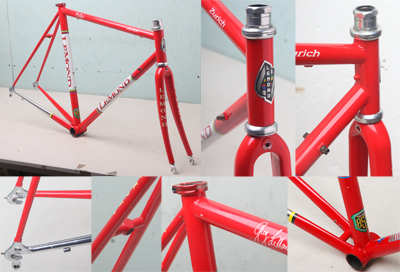
LEMOND ZURICH ROAD FRAME 1990s 22in Reynolds 853
Seat Tube (ctt): 22in (56cm)
Top Tube (ctc): 21.5in (55cm)
Rear dropout width: 130mm
Wheel size: Sprints/700C with a brake drop of 46mm
Seatpost size: 27.2mm
Frame tubing: Reynolds 853
The Lemond 853 frames were built by Trek in the USA in the late 90s/early 2000s. Reynolds 853 was their top frame tubing at the time. This one is in excellent condition and judging by the 1in threaded steerer dates from the 1990s… £275

DAVE LLOYD ROAD FRAME late 1980s 22in
Seat Tube (ctt): 22in (56cm)
Top Tube (ctc): 21.5in (55cm)
Rear dropout width: 128mm
Wheel size: 700C or sprints with brake drop of 46mm
Seatpost size: 27.2mm
Frame Tubing: Reynolds 531C
Dave Lloyd was one of the best and promising British road riders in the early 1970s riding for Peter Post’s all conqeuring Raleigh team but his career was blighted by an irregular heart rhythm which forced a premature retirement. He opened his first shop in the mid 1970s and whilst riding as a pro had learnt some framebuilding from the fabbled Harry Quinn. He went to learn the trade properly from Terry Dolan in the mid 80s before setting his framebuilding business up in 1986. This frame but from Reynolds 531C dates I think from the late 1980s and is really a rather nicely built road frame. The paint whilst not perfect would be in my opinion fine to use… £195
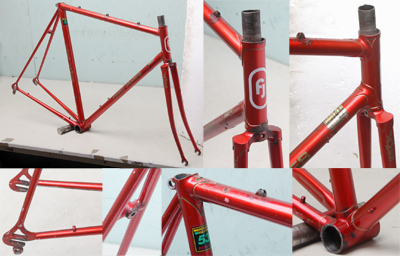
FRED JAMES ROAD FRAME c1976–77 22in
Seat Tube (ctt): 22in (56cm)
Top Tube (ctc): 21.5in (55cm)
Rear dropout width: 124mm
Wheel size: 700C or sprints with brake drop of 51mm
Seatpost size: 27.2mm
Frame Tubing: Reynolds 531 double butted
Fred James’ bikeshop was in Alford, Lincolnshire. I do not think he ever built his own frames – I have seen frames with his shop decals built by Rick Powell and others from Raleigh. But this neither I think – its too early for a Rick Powell frame and not in his or Raleigh’s style. I think its from 1976–77 judging by the early type Campag dropouts, lugs, brake fixings and braze-ons. Its certainly tidily built but the paint is not very good – its certainly worth restoring… £125

DAVE LLOYD CONCEPT 2000 ROAD FRAME 1998 22in
Seat Tube (ctt): 22in (56cm), 19.5in (50cm) ctc
Top Tube (ctc): 21.5in (55cm )
Rear dropout width: 130mm
Wheel size: Sprints/700C with brake drop of 48mm
Seatpost size: 27.2mm
Frame tubing: Dedacciai Zero 18MCDV6
Dave Lloyd was one of the best and promising British road riders in the early 1970s riding for Peter Post’s all conqeuring Raleigh team but his career was blighted by an irregular heart rythym which forced a premature retirement. He opened his first shop in the mid 1970s and whilst riding as a pro had learnt some framebuilding from the fabbled Harry Quinn. He went to learn the trade properly from Terry Dolan in the mid 80s before setting his framebuilding business up in 1986.
However in later years he did not build his own frames – this one I think was almost certainly built to his design at Paul Donahue’s workshop. The wonderful tig welding is typical as is the paint job… £275
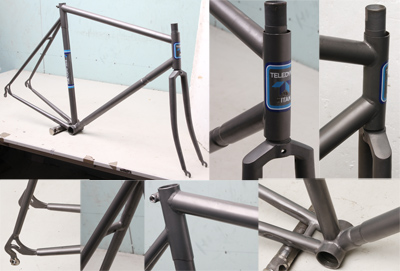
TELEDYNE TITAN ROAD FRAME 1970s 22in Titanium
Seat Tube (ctt): 22in (56cm)
Top Tube (ctc): 22in (56cm)
Rear dropout width: 122mm
Wheel size: Sprints/700C with a brake drop of 53mm
Frame tubing: CP Titanium
Seatpost size: 27.2mm
The Teledyne Titan was the idea of an expatriate Englishman Barry Harvey, though manufactured in California, USA. He formed a company to develop titanium frames but with a lack of capital development work was very slow. He eventually approached Teledyne Linair, a specialist company producing titanium assemblies for the aircraft industry who fortuitously were looking for other applications for titanium. Top and down tube diameters were increased to 1 1/8in and 1 1/4in diameters respectively and wall thicknesses were slightly up compered to a standard steel tubed frame. One rather curious feature of the production frame was how the down tube was necked down to accept standard diameter down tube lever clip and down tube cable guides. This frame is in excellent condition – there are no cracks or dents. £595

KESTREL ROAD FRAME 22in c1990
Seat Tube (ctt): 23.75in (59.5cm), 22in (56cm) ctc
Top Tube (ctc): 22in (56cm)
Rear dropout width: 130mm
Wheel size: Sprints/700C with a brake drop of 47mm
Frame tubing: Carbon-fibre monococque with Time carbon forks
Seatpost size: 27.2mm
Kestrel were one of the pioneers of building carbon-fibre monococque frames – they started in 1986! This frame is in excellent condition with no signs of any accident damage or cracks and dates I think from the early 1990s. It is partnered with a Time carbon-fibre fork. £295
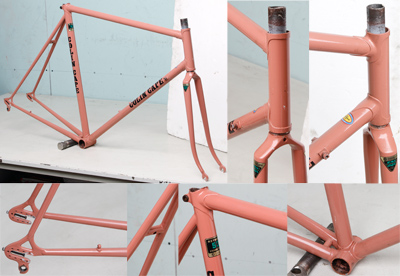
** SPECIAL REDUCED PRICE**
COLIN CAPE ROAD FRAME 1970s
Seat Tube (ctt): 22.25in (56.5cm)
Top Tube (ctc): 22.5in (57cm)
Rear dropout width: 124mm
Wheel size: Sprints/700C with a brake drop of 48mm
Frame tubing: Reynolds 531 double butted
Seatpost size: 27.2mm
Colin Cape was a framebuilder who originally had a shop in Chelmsford, Essex. This frame however dates from the 1970s and time when he had a shop in Swindon – Swindon Cycles. This frame has some nice details such as he drilled rear dropouts and the shot-in seatstays and is in very good condition. It has fairly recently been repainted and this is in very good condition though is quite thick… £149
    
Featured Frames
British and American road frames smaller than 21.5in
British and American road frames 21.5in–22.5in (look below)
British and American road frames larger than 22.5in
Bargain Basement
Classic Road frames pre-1970 smaller than 21.5in
Classic Road frames pre-1970 21.5in–22.5in
Classic Road frames pre-1970 larger than 22.5in
Classic Track & Road-Track frames pre-1970
European frames 56cm or smaller
European frames larger than 56cm
Italian frames 56cm or smaller
Italian frames larger than 56cm
Lo-Pro & Retro Time Trial frames
Touring frames
Track frames

|

SHIPPING COSTS
UK: £12
Europe: £35
North America: £90
Japan, Asia, Australasia, Africa, Middle East, South America: £115
Figures above are good estimates, rates may vary for some countries.
Contact us for more info.
CLICK ON the sale images to see a much larger picture!
FRAME CONDITION CATEGORIES
These categories may be qualified by more detailed description in the text.
All frames I sell are in track and straight, with excellent headset threads, bottom bracket shell threads and gear hanger threads if fitted.
I will make every attempt to ascertain whether paint is original, an older repaint or a more recent repaint. Paint quality does vary quite bit…
Excellent A very useable frame with no obtrusive marks to the paint and no dings or dents. Chrome if present will be free of serious marks unless stated otherwise.
Very Good Perfectly useable frame but with more marks to the paint and chrome if present. Some of the marks may benefit from careful retouching. Generally there will no dents or dings but if present will be small. However if you are concerned about dents/dings with frames in this category please ask me to do an extra check.
Sound Paint and chrome may need redoing depending on how you like your bikes – I appreciate frames with patina which show their age but others may want to repaint. There may be a small ding or two but nothing very significant – older frames often pick up smaller dents which are of no significance to their strength or life. Any more significant dents will be described in the text.
Needing repainting Paint will be poor and in my opinion is not saveable. There may be a small ding or two but nothing very significant – older frames often pick up smaller dents which are of no significance to their strength or life. If there are larger dents they will be described and/or pictured. These are all easily filled by a good framebuilder or frame painter at very little extra cost.
Headsets or bottom brackets fitted to frames are of unknown and unguaranteed condition unless specifically described in the text. Sometimes headsets or bottom brackets will not feel smooth and simply need a service and on other occasions the headset or bottom bracket will need replacing…
For frame without headsets or where you'd like a headset replaced I can offer a fitting service for £15. Please see the headset page: http://hilarystone.com/headset.html for what is available but please bear in mind that you may need advice on whether a particular headset will fit your frame especially in relation to stack height.
|



